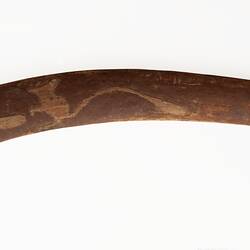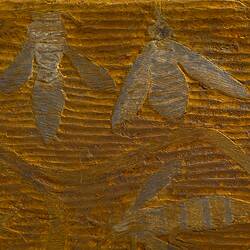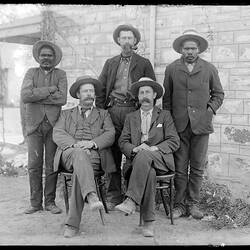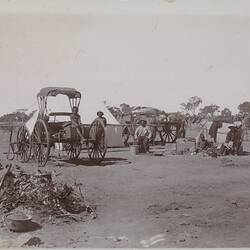Jim Kite Penangke was a Lower Arrernte artist born in the early 1860s who became known for his carvings, illustrations and sculptures, as well as his associations with some early Australian anthropologists. Kite was presumably born close to his ancestral home of Akeltye (later known as McKenzie's Waterhole) sometime soon after the arrival of the first European explorer, John McDouall Stuart. His Arrernte name, Alyelkelhayeka (also spelt Erlikilyika), was translated by the Arrernte and Wangkangurru elder Mick McLean in conversation with T.G.H. Strehlow as meaning 'he slipped, or glided, away' and refers to the actions of kite ancestor in a local 'Dreaming-story' (Strehlow 1968, p.5).
Kite spent most of his life residing nearby to the Charlotte Waters Telegraph Station which was built in 1871. Charlotte Waters became an important stop over location for those travelling into the interior and later became an important hub for a group of Central Australian collectors, scientists and anthropologists (see Mulvaney, Petch & Morphy 2000). The nineteen year old Frank Gillen, who later went on to publish seminal ethnographies of the Arrernte people, appears to have first met Kite in 1875 where he records his Arrernte name as 'Ar-lee'kill-yicca' (Gillen 1875). Gillen, who was employed as the Telegraph Master at Charlotte Waters and later at Alice Springs, was particularly impressed with Kite's reflective and low-key character and affectionately dubbed him 'the Subdued' (Gillen 1968).
In 1901, Spencer and Gillen chose Kite and another man named Warwick (also known as Parunda) to join them on their anthropological expedition from Oodnadatta in South Australia to the Gulf of Carpentaria. During this year long expedition Kite worked not only as a camp assistant but was also called in to assist with the ethnographic research. At Barrow Creek he acted as an interpreter for Kaytetye speakers and made his own symbolic notes with pencil and paper to assist Spencer in his recording of a 'Dreaming-story'. He also filled one of Gillen's notebooks with a number of intriguing illustrations. Kite's voice can also be heard singing his ancestral song from Akeltye on one of the earliest wax cylinder recordings ever made of Aboriginal people (Gibson 2014a).
The medical doctor and anthropologist Herbert Basedow too came to befriend Kite and elicited his services in the interpretation of ceremonies. Basedow later described Kite as 'an unusually talented person' (Basedow 1935, p.108) and made a point of collecting many of the clay sculptures and carvings that he often sold to people visiting Charlotte Waters. With the support of Mr. H.O. Kearnan, Telegraph Master at Charlotte Waters in 1913, Kite exhibited some of his artistic works at the Selborne Hotel in Adelaide to critical acclaim (Gibson 2015, 2014b). This is likely to have been the first solo exhibition of an Aboriginal artist in Australia and many of these works are now held in the South Australian Museum, the National Museum of Australia, the Melbourne Museum, and the Old Timers Museum in Alice Springs. There is no record of Jim Kite's date of death due to the decline in contact with the Charlotte Waters region as the railway bypassed the now defunct Charlotte Waters Telegraph Station. The last anecdotal evidence of his life was in 1923 where his presence was noted during ceremonial activities and a passing reference in the Daily Telegraph in 1926 refers to him as being 'old' (Mulvaney 2001, p.286). His date of death however has been cited as late as 1945 (Kleinert et al. 2000, p.580).
It seems that he and his wife Utnirarenaka Perrurle, (who was from the Arltunga area) had no children.
References
Basedow, H 1935, Knights of the Boomerang: Episodes from a Life Spent Among the Native Tribes of Australia 2nd edn, The Endeavour Press, Sydney.
Gibson, J 2014b, 'Jim Kite's Boomerang: "First Contact" with John McDouall Stuart', in P MacDonald, A Inglis, & G Morrison (eds), For Auld Land Syne: Images of Scottish Australia from First Fleet to Federation, Art Gallery of Ballarat, Melbourne, pp. 122-123.
Gibson, J 2015, 'John McDouall Stuart Remembered in Central Australia', in F Cahir, A Inglis, & S Beggs (eds), Scots Under The Southern Cross, Ballarat Heritage Press, Ballarat, pp. 41-52.
Gillen, FJ 1875, Gillen's First Diary 1875, Wakefield Press.
Gillen, FJ 1968, Gillen's Diary: The Camp Jottings of F. J. Gillen on the Spencer and Gillen Expedition Across Australia, 1901-1902, Libraries Board of South Australia, Adelaide.
Kleinert, S, Neale, M, Anderson, T & Bancroft, R 2000, The Oxford companion to Aboriginal art and culture, Oxford University Press, Melbourne.
Mulvaney, DJ 2001, 'Erlikilyika: Arrente Ethnographer and Artist', in AJ Anderson, I Lilley, & S O'Connor (eds), Histories of Old Ages: Essays in Honour of Rhys Jones, Pandanus Books, Research School of Pacific and Asian Studies, The Australian National University, pp. 277-286.
Mulvaney, J, Petch, A & Morphy, H 2000, From the Frontier: Outback Letters to Baldwin Spencer, Allen & Unwin.
Strehlow, TGH 1968, Book XXVIII: Field Dairy (38) 1968, Strehlow Research Centre, Alice Springs.
More Information
-
Keywords
-
Authors
-
Article types






